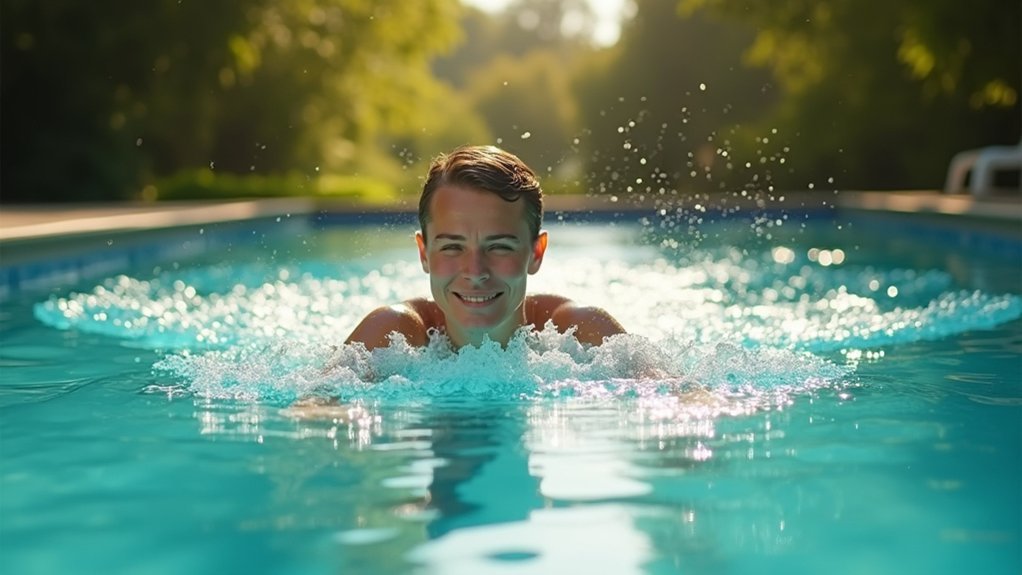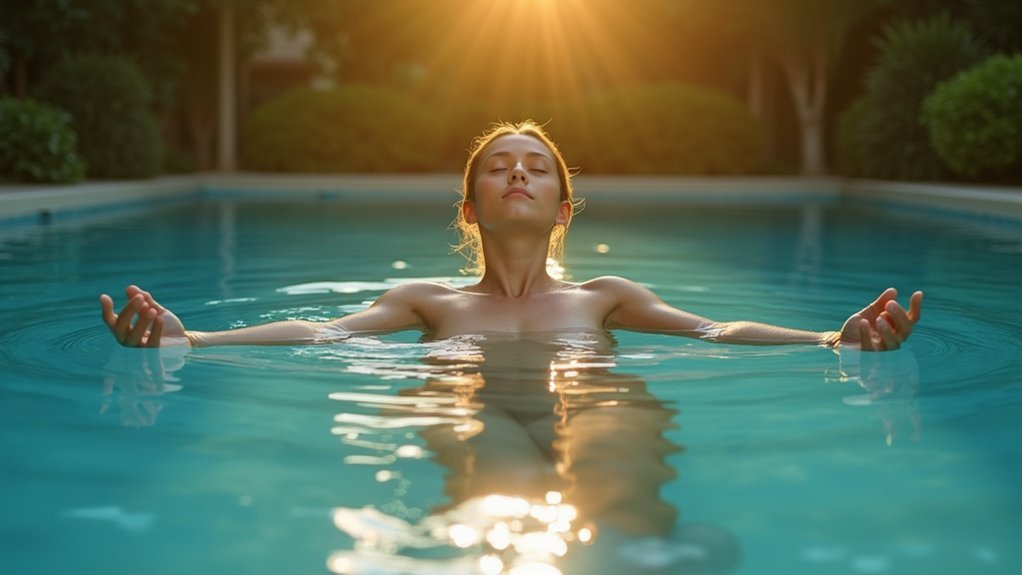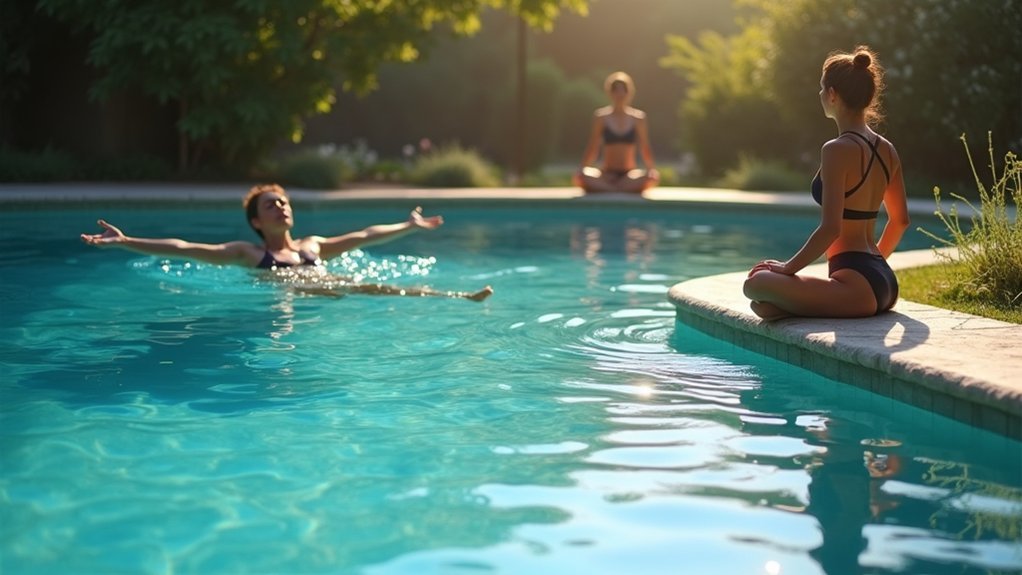For depression relief in the pool, try these three effective therapy moves: First, practice breaststroke swimming with its rhythmic, meditative motion that naturally boosts serotonin and endorphins. Second, engage in water jogging to experience an anxiety-reducing endorphin rush without joint strain. Third, explore floating meditation by lying back in water while focusing on your breath to activate your parasympathetic nervous system. These aquatic exercises offer powerful mental health benefits beyond their physical advantages.
Gentle Swimming Strokes for Releasing Endorphins

While depression often feels like a weight pulling you down, gentle swimming strokes can lift your spirits by triggering a cascade of mood-enhancing chemicals in your brain.
The breaststroke offers an excellent starting point with its rhythmic, meditative movements that promote relaxation and mental clarity.
If you’re seeking stronger endorphin release, try freestyle swimming, which creates a more rapid boost due to increased exertion.
The backstroke provides a uniquely calming experience as you float and breathe freely while still engaging multiple muscle groups.
Each stroke activates your body’s natural production of serotonin, dopamine, and endorphins—powerful neurotransmitters that combat depression symptoms.
The repetitive motion creates a meditative state, helping you break negative thought patterns while the low-impact nature protects your joints.
Healthcare providers now regularly recommend swimming as an effective treatment option for depression due to its powerful combination of physical exercise and stress reduction.
Water Aerobics: Low-Impact Movements for Anxiety Reduction
Water aerobics offers a sanctuary for those battling anxiety, combining the therapeutic properties of water with gentle yet effective movement.
Studies show aquatic exercise can reduce anxiety symptoms by up to 48%, while the warm water environment naturally calms your nervous system and promotes tranquility.
- Aquatic Marching – Enhance cardiovascular health while staying gentle on your joints, perfect if you’re dealing with mobility issues.
- Water Jogging – Experience the endorphin rush of running without the high impact, improving your mood naturally.
- Arm Circles – Strengthen shoulder muscles while practicing mindful breathing techniques that ground you in the present moment.
- Leg Swings – Build lower body strength while the water’s resistance provides a comforting, embracing sensation.
Remember that you don’t need perfect conditions to engage in water therapy; even five minutes of aquatic movement can contribute significantly to your mental health goals.
Floating Meditation: Mindful Buoyancy Techniques

Floating meditation offers a profound pathway to mental calm that goes beyond traditional water exercises. In the sensory-deprived environment of a float tank, you’ll experience heightened mindfulness as external distractions disappear.
The warm water’s buoyancy naturally supports your body, eliminating muscle tension and creating ideal conditions for deep meditation. Focus on breathing awareness to reduce cortisol levels or practice visualization techniques to maintain mental clarity. The weightlessness sensation provides accelerated relaxation response, helping you reach deeper meditative states more quickly than on land.
As you float, your parasympathetic nervous system activates, triggering endorphin release and promoting emotional balance. You’ll likely notice reduced anxiety, improved mood, and enhanced creative thinking.
For depression management, try loving-kindness meditation while floating—directing compassion toward yourself and others. The weightlessness combined with mindfulness creates a powerful therapeutic effect that many find more accessible than land-based meditation practices.
Frequently Asked Questions
How Quickly Can Pool Therapy Show Results for Depression Symptoms?
You’ll notice measurable improvements in depression symptoms within a few weeks of starting pool therapy. Some people experience relief sooner, but consistent participation over 8-20 weeks delivers the most significant, sustainable benefits.
Is Chlorine Exposure Harmful for Mental Health Patients?
Yes, chlorine exposure can harm your mental health. It’s linked to PTSD, anxiety, and neurobehavioral impairments. If you’re already experiencing mental health issues, chlorine exposure might worsen your symptoms.
Can Pool Therapy Replace Traditional Antidepressant Medications?
No, you shouldn’t replace your antidepressants with pool therapy yet. While swimming shows promise as a complementary treatment, current research doesn’t support it as a standalone replacement for medication. Consult your doctor before making changes.
What Water Temperature Is Most Effective for Depression Relief?
You’ll find different temperatures offer unique benefits for depression. Cold water (50-59°F) boosts mood-enhancing neurotransmitters, while warm water (94-100°F) promotes relaxation. Choose based on your symptoms and comfort level for best results.
How Do I Overcome Water-Related Anxiety Before Starting Therapy?
Start by acknowledging your fear, then try gradual exposure near water without entering it. Practice deep breathing and visualization techniques. Consider professional support, and remember you’re in control of your pace throughout the process.
In Summary
You’ve discovered three powerful ways to harness water’s natural healing properties for depression relief. Whether you’re gliding through gentle strokes, engaging in energizing water aerobics, or practicing mindful floating, you’re giving your brain and body exactly what they need. Remember, consistency is key—try incorporating these pool therapy moves into your regular routine. You’ll likely find that water’s buoyant embrace offers both physical relief and emotional renewal.





Leave a Reply